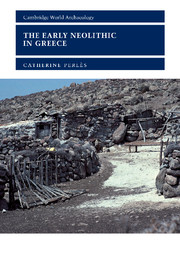Book contents
- Frontmatter
- Contents
- List of figures
- List of tables
- Acknowledgements
- Introduction
- 1 The land and its resources: the geographic context
- 2 The Mesolithic background
- 3 The introduction of farming: local processes, diffusion or colonization?
- 4 Foreign colonists: where from?
- 5 The earliest Neolithic deposits: ‘aceramic’, ‘pre-pottery’ or ‘ceramic’?
- 6 The spread of the Early Neolithic in Greece: chronological and geographical aspects
- 7 A case study in Early Neolithic settlement patterns: eastern Thessaly
- 8 Early Neolithic subsistence economy: the domestic and the wild
- 9 The Early Neolithic village
- 10 Craft specialization: the contrasting cases of chipped-stone tools, pottery and ornaments
- 11 A variety of daily crafts
- 12 Ritual interaction? The miniature world of ‘dolls or deities’
- 13 Interacting with the dead: from the disposal of the body to funerary rituals
- 14 Interactions among the living
- Conclusion
- Bibliography
- Index
9 - The Early Neolithic village
Published online by Cambridge University Press: 18 December 2009
- Frontmatter
- Contents
- List of figures
- List of tables
- Acknowledgements
- Introduction
- 1 The land and its resources: the geographic context
- 2 The Mesolithic background
- 3 The introduction of farming: local processes, diffusion or colonization?
- 4 Foreign colonists: where from?
- 5 The earliest Neolithic deposits: ‘aceramic’, ‘pre-pottery’ or ‘ceramic’?
- 6 The spread of the Early Neolithic in Greece: chronological and geographical aspects
- 7 A case study in Early Neolithic settlement patterns: eastern Thessaly
- 8 Early Neolithic subsistence economy: the domestic and the wild
- 9 The Early Neolithic village
- 10 Craft specialization: the contrasting cases of chipped-stone tools, pottery and ornaments
- 11 A variety of daily crafts
- 12 Ritual interaction? The miniature world of ‘dolls or deities’
- 13 Interacting with the dead: from the disposal of the body to funerary rituals
- 14 Interactions among the living
- Conclusion
- Bibliography
- Index
Summary
In many societies, architecture directly reflects the social organization and symbolic conception of space. The distribution of houses within a settlement, their size and building techniques, the structuring of space and activities within the house, can all relate, to a greater or lesser degree, to the social and sexual relations within the group and to its ideological background. ‘L'architecture domestique – structuration et codification spatiale par excellence – produit et reproduit, dans le temps et pour chaque maisonnée, la vision partagée que la société a du monde’ (Domestic architecture, which implements by excellence a structuration and codification of space, produces and reproduces through time, for each household, the shared vision of the world of the society) (Coudart 1994: 228). At the same time, individual houses materialize the divisions within the group: they emphasize the importance of the lineage, the household or the individual as a discrete unit. Differences in status, wealth or role can thus be expressed in the size, layout or ornamentation of the house. Village architecture thus results from an interplay between collective norms, collectively accepted variations, and individual differentiation.
The respective strength of these three components can vary, however, as do the architectural features that reveal them. I shall argue here that Early Neolithic architecture in Greece is characterized by an unusually high level of intersite variation and change through time. Because of the limited scale of most excavations, intrasite variability is more difficult to assess, but may also have been important.
- Type
- Chapter
- Information
- The Early Neolithic in GreeceThe First Farming Communities in Europe, pp. 173 - 199Publisher: Cambridge University PressPrint publication year: 2001



